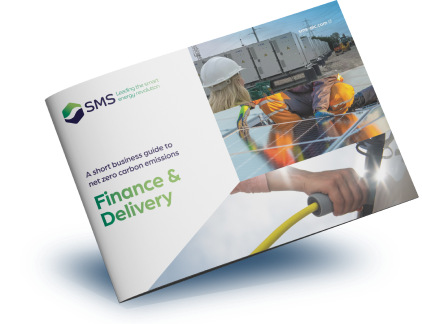How to become a carbon neutral business
Delivering an effective carbon reduction plan that realises long-term sustainability requires expert, strategic advice and access to low-cost asset finance. This guide aims to support you in establishing a zero carbon business journey.

Net Zero Business Guide
We’re not just committed to reducing our own emissions, but helping our customers towards their low-carbon objectives too. Read our guide on how to achieve net zero carbon emissions within your organisation.
1. Reaching net zero carbon: the challenge
In response to the United Nations’ Paris Agreement on climate change, the UK Government in 2019 set out a national target to reduce carbon emissions to ‘net zero’ by 2050. As a result, the country’s energy system is today entering a period of transformation, driven by rapid technological advancements.
Read the UK Government’s Net Zero 2050 Strategy
Often, the tension at the heart of this low-carbon journey centres on the cost of energy, security of supply, and – of course – environmental sustainability. To address these challenges, immediate and increasing action is required, with a major onus being placed on large British organisations to drive forward essential carbon reductions over the coming years.
Increased renewable generation, electrification of heat and transport, and energy efficiencies at a significant scale across all sectors of the UK economy will be essential if net-zero carbon is to be reached.

2. What does net zero carbon mean?
Net zero carbon, otherwise known as ‘carbon neutral’, refers to the process of balancing the amount of carbon (CO2) emitted with the equivalent amount of CO2 emissions cancelled from the atmosphere. For example, replacing petrol and diesel forms of transport with electric vehicles (EVs), or swapping high CO2 emitting practices such as oil, coal and gas-fired energy generation with renewable energy technologies like solar panels, wind farms, and battery storage.
Read more about our committment to becoming a carbon neutral business by 2030
3. What is a net zero target?
There are two types of net-zero target: the first set by an entire country or region – like the UK’s 2050 goal – requiring the whole economy to reduce carbon emissions. The second type of net-zero target is set by progressive, individual organisations who wish to make a positive environmental impact and take a leading role in supporting wider national and global decarbonisation efforts. Here at SMS, for example, we have set our own 2030 net-zero target.
4. Net zero carbon legislation and compliance
At the moment, the only legally-binding target in place for reaching net zero emissions in the UK is the Government’s Net Zero 2050 legislation set in 2019, which applies to the entire UK economy. There is currently no legal obligation on individual organisations to become carbon neutral by any given date. However, under proposed new treasury rules, most big UK firms and financial institutions will be forced to show how they intend to hit climate change targets. By 2023, they will have to set out detailed public plans for how they will move to a low-carbon future – in line with the UK’s 2050 net-zero target.
Besides this, there are already a number of compliance schemes in place for large organisations to report and reduce their energy consumption annually. These include:
Energy Savings Opportunity Scheme (ESOS)
Streamlined Energy and Carbon Reporting (SECR)
Climate Change Agreements (CCA) Compliance Reporting
Energy Intensive Industries (EIIs) exemption
5. The business benefits of carbon reduction and energy efficiency
There are a great number of advantages available for business wishing to embark on a net zero carbon strategy. These include:
Reduce costs, improve productivity
By making a relatively short-term investment in sustainability measures, companies can experience long-term operational efficiencies, whilst reducing costs and improving profits. Don’t just take our word for it, read our case studies.
Build resilience and risk aversion
As the COVID-19 crisis demonstrated, the most resilient, flexible, and well-prepared businesses are the ones that win the day. Besides these unpredictable events, a sustainability strategy builds resilience against the immediate and foreseeable risks too, such as stricter environmental compliance regulations and increased energy costs.
Boost brand image and competitive advantage
Consumers are 58% more likely to buy products or services from an environmentally sustainable and socially responsible business, according to a study by The Natural Marketing Institute. Unlock investment opportunities Global investment analysts recognise that having a sustainability strategy in place is an increasingly critical company criterion. A recent Goldman Sachs study, for instance, found that companies in six industries considered leaders in environmental, social and governance (ESG) policies far outperformed the general stock.
Support recruitment, retention, and employee satisfaction
People increasingly want to work for companies who are “doing the right thing”. According to Adecco, an international HR company, 52% of employees feel their companies should be more environmentally aware.
6. Common challenges to businesses seeking net zero
Business stability in the wake of the global pandemic
After the 2008 global financial crash, 93% of CEOs believed sustainability would become a crucial part of their company’s future success – according to an Adecco survey – as they grappled with the economic impact and the calls for more responsible organisations. In the wake of the COVID-19 pandemic, this sentiment resonates louder still, with governments and the public now demanding businesses to lead a green economic recovery. Finding a balance between financial stability and investment in sustainable responsibility that is increasingly expected of businesses, will therefore be critical as organisations look to the future.
The financial barrier
Many businesses continue to cite cost as the biggest barrier to transitioning to net-zero. Whilst installing sustainable technologies – particularly when rolled out at scale – require substantial initial investment, taking such measures can over time result in long-term profit through the substantial cost savings realised and new revenue streams created. What’s more, with green financing now available to businesses to install these technologies at zero upfront cost, the biggest barrier to sustainability no longer needs to stand in the way of your long-term, low-carbon objectives.
7. What is a net zero carbon strategy?
Reaching net-zero emissions may mean very different things for different organisations, depending upon their size and capacity for energy and carbon reduction, or the specific sectors which they operate in. For energy-intensive industries, realising lower carbon emissions might mean being heavily reliant upon grid decarbonisation or sourcing energy consumption through renewable self-generation. Equally, for organisations with large and complex supply chains, or those with substantial fleets, becoming a net-zero business may see you working much more closely with suppliers to address ‘Scope Three’ emissions.
Whilst there are many different paths to net-zero, SMS aims to make the potential journey as clear and transparent as possible for our customers. For that reason, we have developed a turnkey Net-Zero Framework. Our framework is designed to support any type of large business throughout the planning, implementation and review of long-term energy and carbon reduction programmes, making it easier and more cost effective to realise net-zero goals.
Segmented into four targeted workstreams, our approach identifies the drivers and critical levers existing within an organisation that influence energy and carbon performance, as well as the opportunities to align the strategy delivery across your business and its wider stakeholders.
Our Net Zero carbon strategy service

Data
Uncovering your business data to set the opportunities, boundaries and drivers for energy and carbon reduction.
Projects
We assess the logistical and technical feasibility for low-carbon tech, then finance and deliver your assets, providing ongoing operation and maintenance, and the dedicated consultancy support to review, revise and improve your strategy.
People
Working with your people to identify roles, responsibilities, and risk areas, and the capacity and coverage to consolidate approach across your organisation.
Carbon Roadmap
Establishing your strategy pathway and milestones to provide clarity and transparency, recommending suitable projects and technologies that will deliver on your goals.
8. What’s the difference between carbon reduction and carbon removal?
An organisation’s net-zero emission journey can be broadly categorised into two pathways: carbon reduction and carbon removal. Carbon reduction, or decarbonisation, refers to reducing emissions on an absolute basis, for example, by swapping fossil fuel sources of energy consumption and transport for renewable alternatives. On the other hand, carbon removal – which is often referred to as ‘offsetting’ or ‘sequestration’ – is to do with other measures that can be taken to mitigate CO2 from the atmosphere, such as planting trees, in order to balance an organisation’s overall environmental impact.
Whilst above pathways can be delivered in parallel and can be complementary of each other in the journey to net-zero emissions, our philosophy at SMS is to help our clients prioritise a strategy of true decarbonisation. We do this by enabling our customers to invest in Carbon Reduction (CaRe) technology assets through our financing and project delivery solutions, which maximise business sustainability and long-term value.
9. What are Carbon Reduction (CaRe) assets?
Adopting CaRe assets, or green energy technologies, across your business is an essential part of reaching net zero emissions. Here you can explore our summary of the foremost carbon reduction (CaRe) assets on the market today, which SMS can finance, design, procure, install, operate, and manage as part of a completely integrated delivery service.
10. How to finance a net zero carbon strategy
Many businesses continue to cite cost as the biggest barrier to transitioning to net-zero, with Carbon Reduction (CaRe) technologies – particularly when rolled out at scale – requiring substantial initial investment in order to reap the long-term benefits.
These assets – such as on-site renewable generation, battery storage, low-carbon heat technology, electric vehicles (EV) and EV changepoints – are now more accessible than ever thanks to the flexible renewable energy asset finance options now available, which offer installation, operation and maintenance (O&M) at zero upfront cost.
Financing models for renewable energy assets and other CaRe technologies, include:
Energy Services Company (ESCO) Agreement
Finances the installation of your carbon reduction assets, funded by either SMS or 3rd party finance, including O&M.
Power Purchase Agreement (PPA)
Our PPA option finances on-site renewable generation assets for up to 25 years, with a single agreement to cover the asset, financing, and ongoing operation.
Capital Expenditure (CAPEX)
For organisations who want to part-finance the installation of assets, the CAPEX option enables you to reap the commercial benefits from day one and engage our other energy services such as O&M, through a single agreement.
Energy efficiency grants for businesses
Beyond these private finance options, SMS can also help you unlock access to government grants to support your investment in energy efficiency and low carbon technologies. Example grant mechanisms include:
Industrial Energy Transformation Fund
The Industrial Energy Transformation Fund (IETF) is designed to help businesses with high energy use to cut their energy bills and carbon emissions through investing in energy efficiency and low carbon technologies.
Read more about the Industrial Energy Transformation Fund here
Heat Networks Investment Project
Heat Network Investment Project (HNIP) is a £320 million fund to increase the number of heat networks being built to reduce carbon emissions and deliver carbon savings.
Social Housing Net Zero Heat Fund
The Social Housing Net Zero Heat Fund, owned by the Scottish Government, supports the decarbonisation of social housing in Scotland as part of the Low Carbon Infrastructure Transition Programme (LCITP).
Read about our work with Aberdeen City Council through the Social Housing Decarbonisation Fund (SHDF) Demonstrator to decarbonise their housing stock
11. How to deliver a net zero strategy
We don’t just provide the finance, our experienced consultants and engineers advise on the most suitable CaRe assets to deploy at your sites and take your energy projects from concept to completion – helping you secure board-level buy-in, establish a project delivery model, and install, operate, and manage your assets.
Strategy Design & Development
Our team of experienced advisors provide impartial energy surveys and use energy system modelling to form the basis of your carbon reduction strategy.
Asset Finance
SMS provides the finance to roll out your Carbon Reduction (CaRe) assets at scale and set your strategy in motion.
Supply and Installation
We supply and install all your assets, with no upfront cost.
Operation and Maintenance (O&M)
SMS deliver the ongoing operation to optimise asset performance, including asset maintenance and billing support, if required.
Repower and recycle
At the end of the project life we will decommission and recycle your assets and work with you to repower your project for the next stage of your net-zero transition.
Why work with SMS on your net zero strategy
- We work with you to design, procure, install, operate, and manage your transition to net-zero
- We are technology agnostic and have no affiliation to any technology providers
- Leading partner in net-zero programmes to develop products specific to an organisation’s needs and ambition.
- 25 year heritage and experience in large-scale energy and carbon reduction programme.


Net Zero Business Guide
We’re not just committed to reducing our own emissions, but helping our customers towards their low-carbon objectives too. Read our guide on how to achieve net zero carbon emissions within your organisation.
Discover more
Strategic partner for lower carbon emissions
Our data-driven energy advisory services rationalise consumption, helping set organisations on the most suitable and sustainable path to low-carbon emissions.
Strategy DeliveryLowering the risk of your energy transition
Our asset funding and project delivery solutions are specially designed for the development and rollout of carbon reduction assets and renewable energy technologies at scale.
Delivery OptimisationReducing the cost of energy consumption
Our range of energy bureau and optimisation solutions drive optimum value from your energy portfolio, helping you to lower costs, manage market risks, and enhance efficiency.
Optimisation





